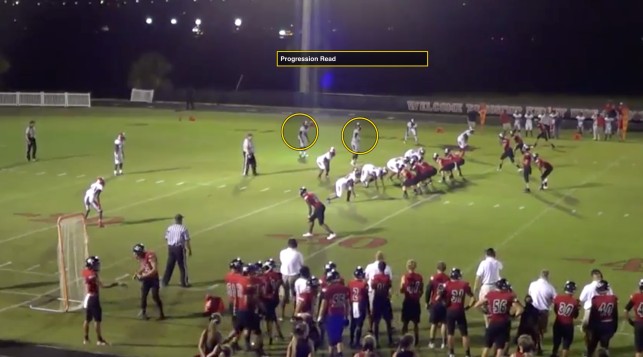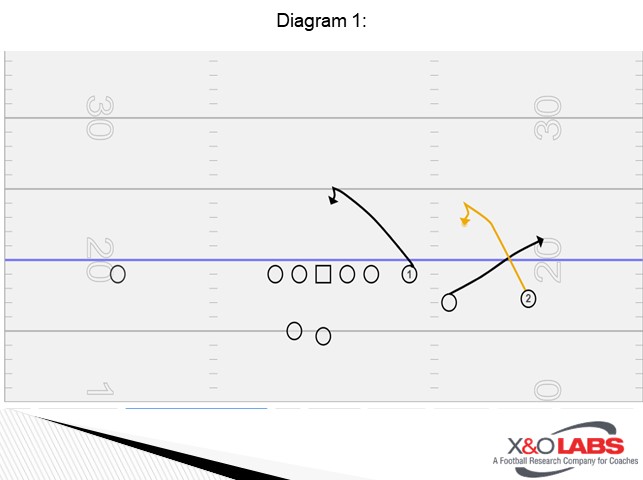By Jeff DiSandro
Offensive Coordinator & Quarterbacks Coach
Bishop Kenny High School (FL)
Twitter: @Coach_disandro
I am going to talk about some of the basics of our passing game. I like to think that our approach with the passing game and pass installation is just one way of “doing simple better.” As I work through our pass game structures, I will also include some specific comments on game planning pertaining to the concepts and ideas being discussed. I am going to intentionally stay away from QB fundamentals discussion for the focus of the article. I want to thank X&O Labs for being a tremendous coaching resource and I know I have learned a ton from other coaches over the past few years.
To start, we are going to break our passing game down into four major types of read families. Our major read categories are progression reads (P), defender keys (K), matchups (M) and combinations (P + 1). All playbook plays and potential additions in the passing game will fit into one of these read families. Each week our staff will spend time analyzing each these structures and how those read families will influence the defense we see (for our advantage). We work hard and drill the QB on the differences between each family and thus how our plays are designed to attack the defense. At times we may seem very multiple; especially in the passing game, but we are not. Every play we have fits into a family of QB read types and once he (the QB) identifies the nature of the family and what we are trying to do he can have confidence and mental command with his processing week to week. I am very picky and about the QB reads in the passing game. As a coach, if I am not 100% certain on what we are trying to accomplish and how it fits into the above-mentioned families then how can I expect the players to be confident? We do build and add as the season goes on but as coaches, we must be certain that how we present plays and our plan to the kids (and the QB) and it must neatly fit into the above schemas we are creating in the passing game. We always talk about putting players in a position to succeed and this is one of the ways we do that regarding throwing the football.

Progression reads (P)
The first family we start training the QB with is our progressions reads. These are pure progressions and the QB will learn to work through a primary, secondary and check down route (1-2-3). With almost all these concepts, we are trying to build some type of 3 man passing triangle. We group all our progressions as either weak triangles, strong triangles or middle triangles. Grouping our progression reads this way helps me arrange my practice and film study teaching time and be efficient and organized with my teaching methods. We like our passing triangles no matter the coverage or defensive structure. These are calls that we like to think of as “coverage proof.” This just means that we don’t look for a specific cover 3 or cover 2 looks to work a certain progression. Through the game planning, the coaching staff will decide how we want to flood the field or what specific triangles we want to use. Using formations and different motions, we are always trying to find ways to put our 3 on their 2 or our 3 on their 3 with some type of winning leverage. Again, we can deploy a variety of progression reads and the QB can feel confident in being diverse so long as we communicate the family and get him to understand how this play influences the defense.

QB progression is sit, curl, flat. This is a strong triangle.
Game plan thoughts would be how do you want to flood the field (formations?). No matter how many ways you choose to do it the family the basics don’t change for the QB. What personnel groups and formations will utilize your best players and put them in primary or secondary spots in the route concept? For example, will you see middle blitz in a certain area of the field, and can you work the middle sit to an explosive athlete in that situation? That could require you to move an athlete around a little, but the basics and nature of the play don’t change at all.
One of the big things with the QB in the progression read family is for him to avoid locking into a wide receiver during the play. We work hard on repping the QB and his eyes and we want to create good habits of field awareness in the progression passing game. One of the drills I use for progression reading is shown below. We do a lot with the drill. Not only is this a good way for the QB to develop the ability to move through progressions and create some situational awareness but it is also a good way for me, as the coach, to teach the defensive coverage reactions and how the weeks opponent will match our concepts. It is the QB’s job to evaluate those spots (or a phrase I use is do you want to buy this land) and throw the football into the open grass. As mentioned above the QB cannot lock into a WR. A lot of the interceptions that happen on progression reads can be traced back to locking onto a WR in the progression and losing that awareness - thus not feeling/seeing a defender that eventually can make a play on a throw. All the QB footwork is tied into the progression, meaning he always has rhythm, hitch 1 or hitch 2 with the internal clock in his head.
Drill 1 - Progression Drill Ideas
3 cones will act as routes being run into the appropriate areas. Our spacing concept has a sit over the center at six yards, a mini-curl that adjusts off the flat defender and an arrow / flat throw. The colored mesh or cloth will form a box around the route to help the QB gain specific progression or triangle awareness. We talk the QB through each route in the progression and review how the trigger players may or may not meet the colored mesh near the cone and route. We will cover how the specific defense that week will react to our spacing progressions. All of this is designed to get him to play with triangle awareness within his progression reads. I also use this drill to review any special scenarios and play call situations we might encounter.
The drill is a good way to teach about defenders within the coverage scheme and how spots of the field get covered and routes become dead thus moving the QB to his next progression. The drill has some flexibility because the coach can work specific parts of the progression, simulate different defender tendencies or have the QB just work eyes and throwing to open grass based on simulated awareness. One way we would add to the first skill is to add a pressure or pocket movement component to the drill. We will still work QB football and progressions all the same but add a 3-man DL rush and force the QB to fit in the pocket a variety of different ways while keeping his eyes down the field.
This is our spacing concept to the trips side. The QB reads are Sit, Curl, Flat. We would like the #1 WR to throttle into the open area or grass better in this situation. We teach this curl as adjust off the flat area and he can sit in a first window or second window based off the flat defender response. He should present numbers and hand target for the QB. #2 (the flat route) must get width as his route really helps create the stron
Offensive Coordinator & Quarterbacks Coach
Bishop Kenny High School (FL)
Twitter: @Coach_disandro
I am going to talk about some of the basics of our passing game. I like to think that our approach with the passing game and pass installation is just one way of “doing simple better.” As I work through our pass game structures, I will also include some specific comments on game planning pertaining to the concepts and ideas being discussed. I am going to intentionally stay away from QB fundamentals discussion for the focus of the article. I want to thank X&O Labs for being a tremendous coaching resource and I know I have learned a ton from other coaches over the past few years.
To start, we are going to break our passing game down into four major types of read families. Our major read categories are progression reads (P), defender keys (K), matchups (M) and combinations (P + 1). All playbook plays and potential additions in the passing game will fit into one of these read families. Each week our staff will spend time analyzing each these structures and how those read families will influence the defense we see (for our advantage). We work hard and drill the QB on the differences between each family and thus how our plays are designed to attack the defense. At times we may seem very multiple; especially in the passing game, but we are not. Every play we have fits into a family of QB read types and once he (the QB) identifies the nature of the family and what we are trying to do he can have confidence and mental command with his processing week to week. I am very picky and about the QB reads in the passing game. As a coach, if I am not 100% certain on what we are trying to accomplish and how it fits into the above-mentioned families then how can I expect the players to be confident? We do build and add as the season goes on but as coaches, we must be certain that how we present plays and our plan to the kids (and the QB) and it must neatly fit into the above schemas we are creating in the passing game. We always talk about putting players in a position to succeed and this is one of the ways we do that regarding throwing the football.

Progression reads (P)
The first family we start training the QB with is our progressions reads. These are pure progressions and the QB will learn to work through a primary, secondary and check down route (1-2-3). With almost all these concepts, we are trying to build some type of 3 man passing triangle. We group all our progressions as either weak triangles, strong triangles or middle triangles. Grouping our progression reads this way helps me arrange my practice and film study teaching time and be efficient and organized with my teaching methods. We like our passing triangles no matter the coverage or defensive structure. These are calls that we like to think of as “coverage proof.” This just means that we don’t look for a specific cover 3 or cover 2 looks to work a certain progression. Through the game planning, the coaching staff will decide how we want to flood the field or what specific triangles we want to use. Using formations and different motions, we are always trying to find ways to put our 3 on their 2 or our 3 on their 3 with some type of winning leverage. Again, we can deploy a variety of progression reads and the QB can feel confident in being diverse so long as we communicate the family and get him to understand how this play influences the defense.

QB progression is sit, curl, flat. This is a strong triangle.
Game plan thoughts would be how do you want to flood the field (formations?). No matter how many ways you choose to do it the family the basics don’t change for the QB. What personnel groups and formations will utilize your best players and put them in primary or secondary spots in the route concept? For example, will you see middle blitz in a certain area of the field, and can you work the middle sit to an explosive athlete in that situation? That could require you to move an athlete around a little, but the basics and nature of the play don’t change at all.
One of the big things with the QB in the progression read family is for him to avoid locking into a wide receiver during the play. We work hard on repping the QB and his eyes and we want to create good habits of field awareness in the progression passing game. One of the drills I use for progression reading is shown below. We do a lot with the drill. Not only is this a good way for the QB to develop the ability to move through progressions and create some situational awareness but it is also a good way for me, as the coach, to teach the defensive coverage reactions and how the weeks opponent will match our concepts. It is the QB’s job to evaluate those spots (or a phrase I use is do you want to buy this land) and throw the football into the open grass. As mentioned above the QB cannot lock into a WR. A lot of the interceptions that happen on progression reads can be traced back to locking onto a WR in the progression and losing that awareness - thus not feeling/seeing a defender that eventually can make a play on a throw. All the QB footwork is tied into the progression, meaning he always has rhythm, hitch 1 or hitch 2 with the internal clock in his head.
Drill 1 - Progression Drill Ideas
3 cones will act as routes being run into the appropriate areas. Our spacing concept has a sit over the center at six yards, a mini-curl that adjusts off the flat defender and an arrow / flat throw. The colored mesh or cloth will form a box around the route to help the QB gain specific progression or triangle awareness. We talk the QB through each route in the progression and review how the trigger players may or may not meet the colored mesh near the cone and route. We will cover how the specific defense that week will react to our spacing progressions. All of this is designed to get him to play with triangle awareness within his progression reads. I also use this drill to review any special scenarios and play call situations we might encounter.
The drill is a good way to teach about defenders within the coverage scheme and how spots of the field get covered and routes become dead thus moving the QB to his next progression. The drill has some flexibility because the coach can work specific parts of the progression, simulate different defender tendencies or have the QB just work eyes and throwing to open grass based on simulated awareness. One way we would add to the first skill is to add a pressure or pocket movement component to the drill. We will still work QB football and progressions all the same but add a 3-man DL rush and force the QB to fit in the pocket a variety of different ways while keeping his eyes down the field.
This is our spacing concept to the trips side. The QB reads are Sit, Curl, Flat. We would like the #1 WR to throttle into the open area or grass better in this situation. We teach this curl as adjust off the flat area and he can sit in a first window or second window based off the flat defender response. He should present numbers and hand target for the QB. #2 (the flat route) must get width as his route really helps create the stron









